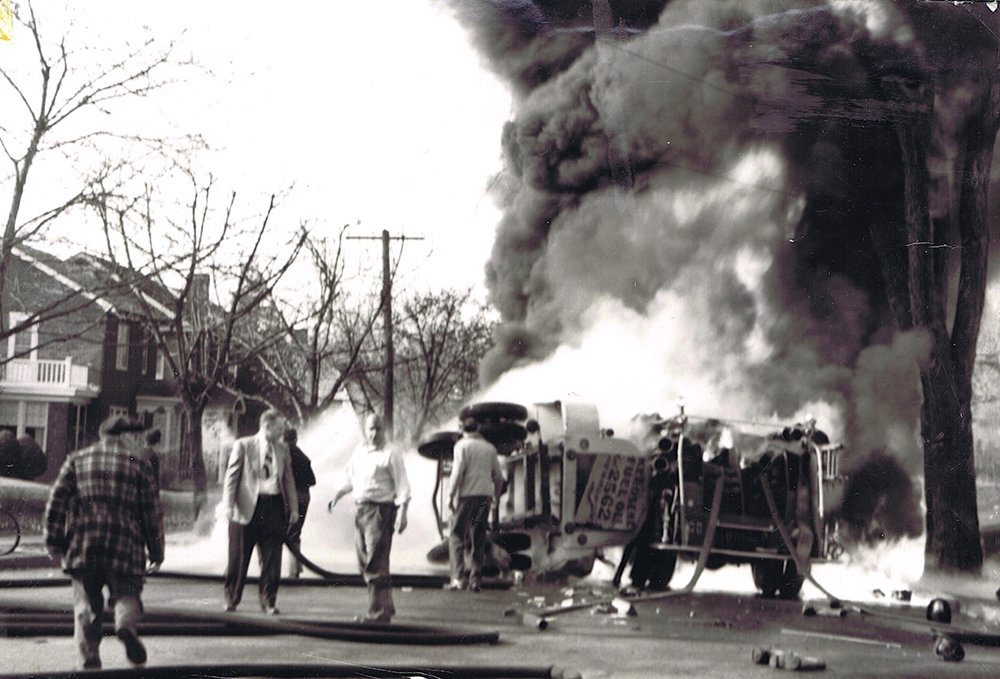
Helmets & boots are scattered on the pavement where firemen were thrown from their engine.
By Mary McTamaney
It was a morning like these we are having – crisp sunshine and a breeze blowing away the final leaves of autumn. Children were in school that Friday morning and adults were busy at their jobs. That included the men of the Newburgh Fire Department. They had gone out to test a sprinkler system on Broadway, responded to a rubbish fire on Mill Street, and then a truck fire on West Street. A second apparatus was dispatched to help with the burning truck at West and Third Streets but never made it to the scene. It became its own fiery tragedy. As it downshifted into the intersection of South Street and Fullerton Avenue heading west, just beside Newburgh Free Academy, it was struck hard by an oil truck owned by Newburgh Ice, Coal and Fuel Oil Company coming north on Fullerton. The ensuing explosions and fires still rank as one of Newburgh’s great tragedies.
The owner of 175 Fullerton Avenue, Mrs. Selke, was standing at her kitchen sink preparing lunch that late morning of December 3, 1954. She heard the crash and saw a burning mushroom of flame erupt between the two vehicles. Oil and gas leaked onto the pavement and sent tongues of flame rolling toward parked cars on both sides of South Street. Injured men lay at various places in the intersection. They were the four firemen who had been riding the back step of Engine #1 and had been thrown clear during the crash. As the fuel truck blazed, Lieutenant Fred Carpenter, who had just crawled from his firetruck, jumped up onto the door of the oil trucks’s sideways cab and pulled the driver, Ronald Bevier, up and out. He placed Mr. Bevier on the ground and covered him with his heavy turnout coat to smother the flames burning the young driver’s body. NFA teacher Stan Hemingway, custodian George Elwood and student John Giametta, carried the most seriously injured fireman, who had been lying unconscious in the road, to the safety of the NFA tree lawn. The other firemen helped each other stand and fight the blaze. Francis Whitaker, a rookie fireman that day who would someday become the department chief, pulled a line of hose over to the corner hydrant and the firemen starting pumping water on the trucks under the direction of their Lieutenant who had blood streaming down his face from a deep head wound.
As moments passed, the surrounding parked cars caught fire as did the 50-foot-tall trees lining South Street. The neighborhood watched in horror. Mrs. Selke’s yard filled up with spectators as did the grassy slope outside NFA. School principal, Robert Fowler, told a reporter how much worse things might have been if the crash had happened only ten minutes later. At noon, the bell would have rung dismissing hundreds of teenagers to head outside for lunch. Those students might have been at the curbs as the two trucks collided. On a cold early December day, several would have eaten their lunches huddled in their cars. Instead, they watched in horror from the classroom windows.
Police and ambulances soon arrived at the scene. Other firemen took over the clean-up of the fire until 1:30 that afternoon. Oil truck driver Bevier and the firemen of Engine #1 were taken away to the hospital where the truck driver was pronounced dead from his burns. One fireman, Charles Clancy, the man carried to safety by school personnel, was in critical condition with head injuries suffered when he was thrown from the back step of the engine. Lt. Fred Cathcart was admitted for a broken wrist, head lacerations and burns. Four other firemen were treated for burns, cuts and sprains and released from St. Luke’s. Six cars were destroyed and a few more damaged along the sides of South Street. The explosions of their gas tanks only added to the danger and destruction.
NFA alumni and west end residents who were alive in 1954 clearly remember the fiery tragedy that shook their peaceful morning sixty-six years ago. So do the families of the victims each year as December approaches.